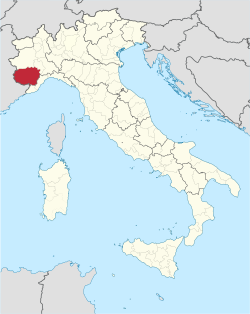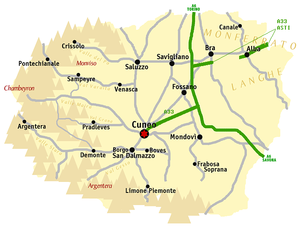The province of Cuneo (Italian: provincia di Cuneo; Piedmontese: provincia ëd Coni) is a province in the Piedmont region of Italy. To the west, it borders the French region of Provence-Alpes-Côte d'Azur (departments of Alpes-Maritimes, Alpes-de-Haute-Provence and Hautes-Alpes), to the north the Metropolitan City of Turin, to the east the province of Asti and to the south the Ligurian provinces of Savona and Imperia. It is also known as la Provincia Granda (Piedmontese for 'The Big Province'), because it is the largest province in Piedmont and the fourth-largest in Italy (following Sassari, South Tyrol and Foggia).[2] Briga Marittima and Tenda were part of this province before their cession to France in 1947.[3]
Province of Cuneo
| |
|---|---|
 The provincial seat | |
 Map highlighting the location of the province of Cuneo in Italy | |
| Country | Italy |
| Region | Piedmont |
| Capital(s) | Cuneo |
| Comuni | 250 |
| Government | |
| • President | Luca Robaldo |
| Area | |
• Total | 6,902 km2 (2,665 sq mi) |
| Population (30 June 2016) | |
• Total | 590,309 |
| • Density | 86/km2 (220/sq mi) |
| GDP | |
| • Total | €17.987 billion (2015) |
| • Per capita | €30,423 (2015) |
| Time zone | UTC+1 (CET) |
| • Summer (DST) | UTC+2 (CEST) |
| Postal code | 12100 |
| Telephone prefix | 0171 |
| Vehicle registration | CN |
| ISTAT | 004 |
| Website | www |

Administration
editIts capital is the city of Cuneo.[4] Of the 250 comuni in the province, the largest by population are:
| Commune | Population |
|---|---|
| Cuneo | 56,201 |
| Alba | 31,346 |
| Bra | 29,593 |
| Fossano | 24,306 |
| Mondovì | 22,730 |
| Savigliano | 21,526 |
| Saluzzo | 16,971 |
| Borgo San Dalmazzo | 12,457 |
| Busca | 10,116 |
| Racconigi | 10,094 |
| Boves | 9,807 |
| Cherasco | 9,128 |
| Barge | 7,694 |
| Dronero | 7,065 |
Economy
editCompanies active in the province include:
- Michelin in Mondovì
- Miroglio in Alba
- Ferrero SpA in Alba
- Maina in Fossano
- Balocco in Fossano
- Merlo in San Defendente (Cervasca)
- Arpa industriale in Bra
- Bottero in Cuneo
- Mondo in Alba
- Mtm-Brc in Cherasco
- Abet in Bra
- Edizioni San Paolo in Alba
Many important industrial groups have branches in the province: Michelin (Cuneo and Fossano), Saint-Gobain (Savigliano), Valeo (Mondovì), Asahi Glass Co. (Cuneo), ITT (Barge), Diageo (Santa Vittoria d'Alba) and Nestlé (Moretta).[5]
Cuneo is also the land of important wines, mostly produced in the Langhe and Roero hills, such as Barbaresco, Barolo, Nebbiolo, Barbera and many others.
See also
editReferences
edit- ^ Regions and Cities > Regional Statistics > Regional Economy > Regional Gross Domestic Product (Small regions TL3), OECD.Stats. Accessed on 16 November 2018.
- ^ Bole 2011, p. 82.
- ^ Construction de l'espace au Moyen Age: pratiques et représentations [Construction of space in the Middle Ages: practices and representations] (in French). Publications de la Sorbonne. 2007. p. 391. ISBN 978-2-85944-587-4.
- ^ Kresl & Ietri 2010, p. 138.
- ^ Holst-Warhaft & Steenhuis 2012, p. 76.
Sources
edit- Bole, David (2011). Innovative policies for Alpine towns: Alpine space small local urban centres innovative pack. Založba ZRC. ISBN 978-961-254-254-2.
- Holst-Warhaft, Gail; Steenhuis, Tammo (28 November 2012). Losing Paradise: The Water Crisis in the Mediterranean. Ashgate Publishing, Ltd. ISBN 978-1-4094-8846-0.
- Hall, Marcus (2005). Earth Repair: A Transatlantic History of Environmental Restoration. University of Virginia Press. ISBN 978-0-8139-2341-3.
- Kresl, Peter Karl; Ietri, Daniele (2010). The Aging Population and the Competitiveness of Cities: Benefits to the Urban Economy. Edward Elgar Publishing. ISBN 978-1-84980-693-0.

